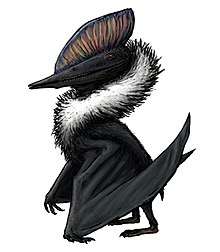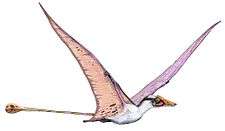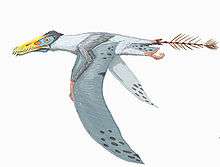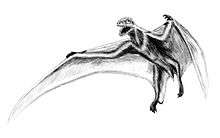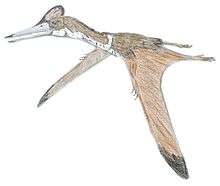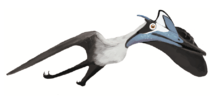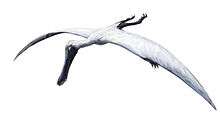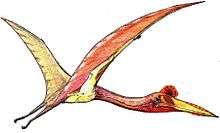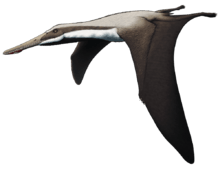Eupterodactyloidea
Eupterodactyloidea (meaning "true Pterodactyloidea") is an extinct group of pterodactyloid pterosaurs that existed from the latest Late Jurassic to the latest Late Cretaceous periods (Tithonian to Maastrichtian stages). Eupterodactyloids lived on all continents except Antarctica.[1]
| Eupterodactyloids | |
|---|---|
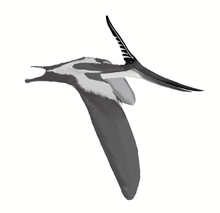 | |
| Life restoration of the pteranodontian Pteranodon longiceps | |
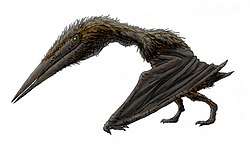 | |
| Restoration of Aerotitan sudamericanus depicted as an azhdarchid | |
| Scientific classification | |
| Kingdom: | Animalia |
| Phylum: | Chordata |
| Order: | †Pterosauria |
| Suborder: | †Pterodactyloidea |
| Infraorder: | †Eupterodactyloidea Bennett, 1994 |
| Subgroups | |
Classification
Eupterodactyloidea was named by S. Christopher Bennett in 1994 as an infraorder of the suborder Pterodactyloidea. Bennett defined it as an apomorphy-based clade.[2] However, in 2010, Brian Andres re-defined the group as a stem-based taxon in his dissertation,[3] and then formalized the definition in 2014 as all pterosaurs more closely related to Pteranodon longiceps than to Pterodactylus antiquus.[4] The slightly more exclusive group Ornithocheiroidea was re-defined in 2003 by Alexander Kellner. He defined it as the least inclusive clade containing Anhanguera blittersdorffi, Pteranodon longiceps, Dsungaripterus weii, and Quetzalcoatlus northropi. Ornithocheiroidea has often been used for a much more inclusive group including only the branch of traditional ornithocheirid pterosaurs, though this use has since fallen out of favor by many researchers after years of competing definitions for the various pterodactyloid clades. The compromise definitions by Andres and others have since become more widely adopted.
Below is a cladogram showing the results of a phylogenetic analysis presented by Andres et al. 2014,[4] and updated by Longrich, Martill, and Andres, 2018.[5] Andres and colleagues followed this definition, and also used a branch-based definition for Eupterodactyloidea, making them very similar in content.[4]
| Pterodactyloidea |
| ||||||||||||||||||||||||||||||||||||||||||||||||||||||
References
- Richard J. Butler; Stephen L. Brusatte; Brian B. Andres; Roger B. J. Benson (2012). "How do geological sampling biases affect studies of morphological evolution in deep time? A case study of the Pterosauria (Reptilia: Archosauria)". Evolution. 66 (1): 147–162. doi:10.1111/j.1558-5646.2011.01415.x. PMID 22220871.
- S. Christopher Bennett (1994). "Taxonomy and systematics of the Late Cretaceous pterosaur Pteranodon (Pterosauria, Pterodactyloidea)". Occasional Papers of the Natural History Museum of the University of Kansas. 169: 1–70.
- Andres, Brian Blake (2010). Systematics of the Pterosauria. Yale University. p. 366. A preview that shows the cladogram without clade names
- Andres, B.; Clark, J.; Xu, X. (2014). "The Earliest Pterodactyloid and the Origin of the Group". Current Biology. 24 (9): 1011–6. doi:10.1016/j.cub.2014.03.030. PMID 24768054.
- Longrich, N.R., Martill, D.M., and Andres, B. (2018). Late Maastrichtian pterosaurs from North Africa and mass extinction of Pterosauria at the Cretaceous-Paleogene boundary. PLoS Biology, 16(3): e2001663. doi:10.1371/journal.pbio.2001663

